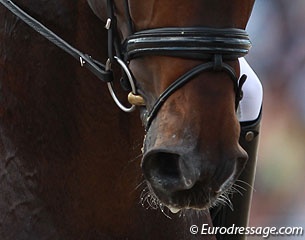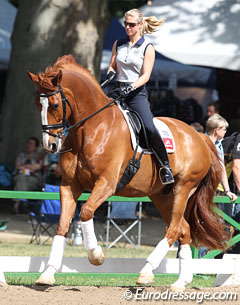
A question that is met by every competitive dressage rider is when to move from the snaffle bridle to the double bridle. How do you know when to make that transition? How can you make the transition as seamless as possible? Once you have established the contact in the double, should you still go back to the snaffle, and how often? Are some horses better in the double, and some better in the snaffle, and why?
I recently began the two times changes on Batialo and I did this using the snaffle bridle. No I don’t always use the snaffle, but I chose to start the more difficult sequence of tempi changes in the snaffle to ensure that I had the horse in front of my leg and onto the contact, but also in balance and listening to my seat, and not being held up or restricted by my reins.
This does not mean that the double bridle is less effective, but it does sometimes hide things that are more obvious in the snaffle bridle. If you see a rider pulling their way through a series of times changes, chances are if you put them in a snaffle bridle, they would have a lot of trouble maintaining a constant rhythm and keeping their horse in balance.
So I set out to find out when you should make that move to the double bridle, why, and if the snaffle should still be used as a check that everything is going according to plan, i.e. are the basics still in place.
For British Olympian Laura Bechtolsheimer there is no exact rule as to when you should make that first move from the snaffle to the double bridle. I depends entirely on the horse. “I tend to do it aged 7 but the really important thing is that a horse is ready, regardless of its age, i.e. accepting the snaffle well and working in a good and happy contact," said Laura.
 Once you have ensured that your horse is ready, Laura recommends introducing the double bridle gradually and ease the horse into it with less demanding work. “Firstly, use the double a few times in the week, just for easy work or hacking at the start, so that the horse is not put under any real pressure when dealing with this new feeling in the mouth. As the horse increases in confidence and accepts the new bits then the horse can be worked more normally in the double. I would always keep working in the snaffle a few times a week too so that one is never tempted to rely on the double to fix basic problems.”
Once you have ensured that your horse is ready, Laura recommends introducing the double bridle gradually and ease the horse into it with less demanding work. “Firstly, use the double a few times in the week, just for easy work or hacking at the start, so that the horse is not put under any real pressure when dealing with this new feeling in the mouth. As the horse increases in confidence and accepts the new bits then the horse can be worked more normally in the double. I would always keep working in the snaffle a few times a week too so that one is never tempted to rely on the double to fix basic problems.”
Using the snaffle to keep a check on this, Laura believes that a well trained horse should go well in both bits and that both bits have their use in dressage training. “The snaffle works very differently to the double. The snaffle is one bit and gives no leverage, the contact is direct to the horse's mouth. It's softer and more gentle and therefore when you work a horse through in a snaffle you get a very real feeling of your horse and how it feels in the body.”
If you find that when you go back to the snaffle you lose that elastic connection to the horse's mouth and you feel that he is not working through correctly over the back, did you really have it in the double? Or was it just more easily hidden?
“The double is two bits, one with leverage and much stronger acting on the mouth. It is easier to damage a contact if the double is used incorrectly by untidy hands or having the curb too tight and using it to force a horse to do what it doesn't want to do in a snaffle," Laura explained.
While the double is the required bridle for top level dressage, it should not be used to force the horse onto the bit and until you can alternate between bridles with fluency, then perhaps you should stick to the snaffle for a little while longer, or at least go back to it and reaffirm the basics, before reintroducing the double!
“The double bridle is a piece of tack that should be used when a horse can be ridden with the finest and subtlest of aids,” Laura stated. "Therefore not as a scapegoat for poor horsemanship!"
by Sarah Warne for Eurodressage
Photos © Astrid Appels/Eurodressage
Related Link
Sarah Warne's Classical Training Articles